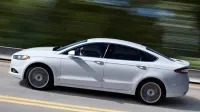New Ford Fusion not likely to oust top-selling Toyota Camry, yet

This time, however, Ford may have a case.
The Camry remains the default choice for Baby Boomers.
Offering five powertrains, including a 47-mile-per-gallon gas-electric hybrid, and a powerful 2.0-liter EcoBoost model, all wrapped in a sexy exterior, the Fusion makes a strong case that it deserves a spot at the top of America’s most cutthroat segment.
But numbers don’t lie.
Last year, Ford sold 248,000 Fusions. This year, sales are up 7.7 percent through August at 181,000 cars, making the Fusion Detroit’s top selling midsize car in America. But it’s not even close to the top selling midsize car in the U.S., it’s not even the third-best-selling midsize sedan. The Camry is on a big rebound. It has sold 280,000 cars this year alone, and sales are up 37 percent. It could sell 400,000 cars by year’s end. Meanwhile, through August, the Honda Accord at 219,000 cars (sales up 19 percent) and the Nissan Altima is at 210,000 units.
Furthermore, the Camry remains the default choice for Baby Boomers. Style and performance be damned, these customers have always had a Camry and always will have a Camry. So Ford, admittedly, has its work cut out for it.
Furthermore, the Fusion, which was originally assembled in Mexico, faced capacity limits, never having the ability to build as many Camrys as Toyota could. However, with the change over to the Flat Rock, Michigan, factory, which also builds the Mustang, Ford will have the ability to match Toyota’s capability.
Ford expects a conquest rate around 50 percent overall and about 70 percent for the hybrid.
But that will only be necessary if there’s a true demand for the new car.
According to Sam Hoyt, Fusion brand manager, Ford expects big growth in Fusion sales next year, topping last year’s high mark, though she would not give specific numbers.
“We’ve got to get more customers in places on the east and west coasts in order to grow,” said Hoyt of the traditional import-centric regions.
Of the initial four powertrains offered, Hoyt says roughly 15 percent of new Fusion sales will be hybrids, 15 percent will be 2.0-liter turbocharged models – including the high-end Titanium – 35 percent will have the base 2.5-liter engine under the hood and 35 percent will be powered with Ford’s 1.6-liter EcoBoost four-cylinder. Of course, those are just the original expectations. Ford plans on being able to quickly adapt if demands change.
Hoyt says that Ford expects a conquest rate around 50 percent overall and about 70 percent for the hybrid.
“It could be even higher,” Hoyt said.
Perhaps. And while the new Fusion bests the Camry in many areas at first blush, it’s not likely to depose it as sales leader in the coming years.
But give it time. This race is far from over.




